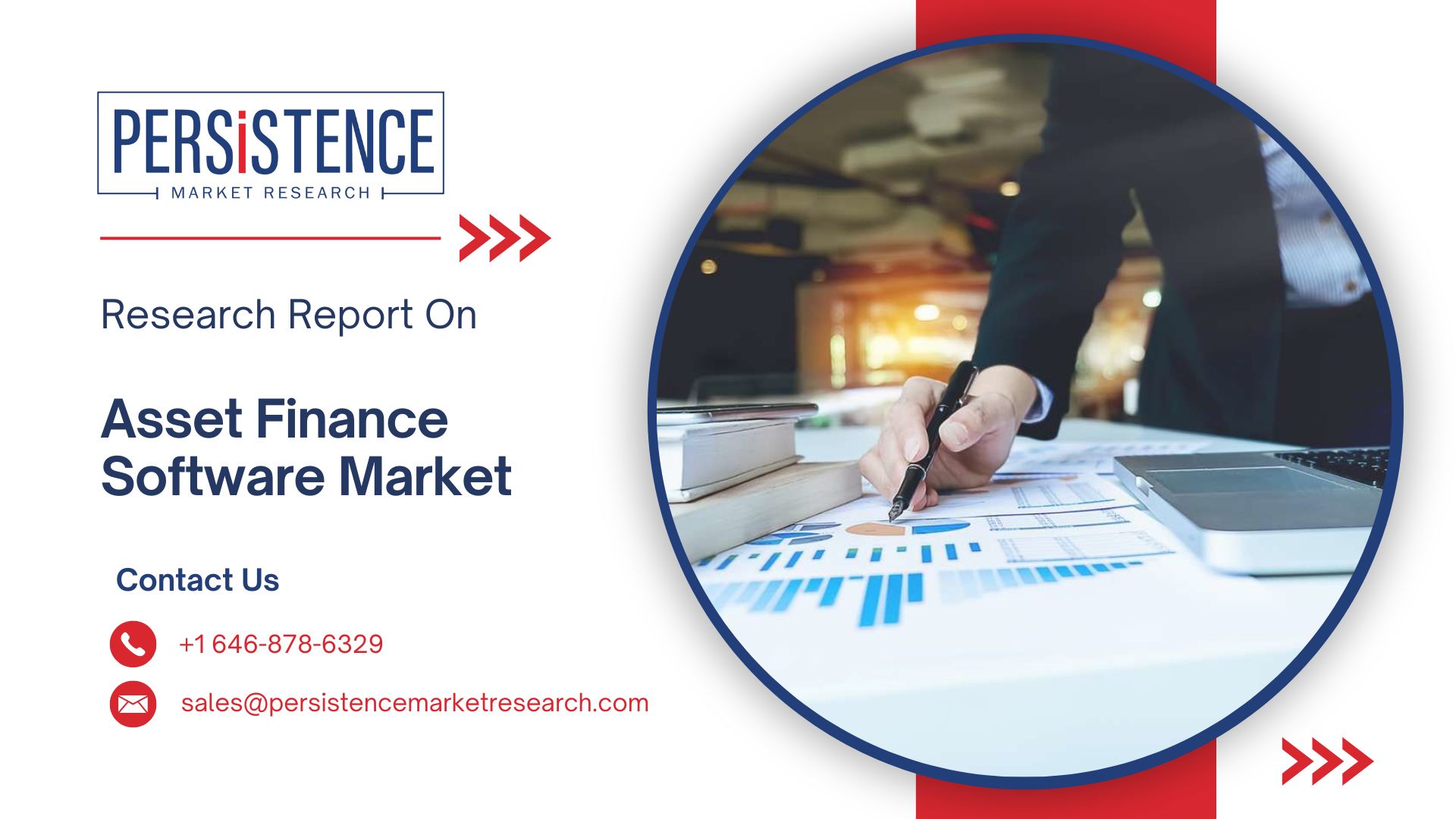Is the Asset Finance Software Market Worth Investing in 2025?

The asset finance software market has gained significant attention over the past few years, thanks to the growing adoption of digital solutions across financial services. As businesses look for ways to streamline operations, enhance customer experiences, and manage risks more efficiently, asset finance software has emerged as a key enabler of this transformation. But with the market evolving rapidly, many investors are asking the crucial question: Is the asset finance software market worth investing in 2025?
According to Persistence Market Research, the global asset finance software market size is predicted to reach US$ 9,098.5 million by 2032, up from US$ 4,273.4 million in 2025. This growth represents a CAGR of 11.4% between 2025 and 2032. The projected market expansion highlights a growing demand for efficient, scalable, and innovative solutions in the asset finance sector, making it an attractive investment opportunity.
In this article, we will dive into the factors driving the market’s growth, explore the key opportunities and risks, and provide insights into why the asset finance software market is likely to be a smart investment choice in 2025 and beyond.
Key Drivers of Growth in the Asset Finance Software Market
The growth of the asset finance software market is being driven by several factors, each contributing to the increasing need for advanced software solutions in the financial sector. Understanding these drivers is crucial for investors looking to assess the market’s potential.
1. Digital Transformation of Financial Services
The financial industry is undergoing a significant digital transformation, and asset finance is no exception. Financial institutions are shifting from manual processes to automated, data-driven solutions, and asset finance software is at the heart of this change.
- Automation of Loan Processing: With automation capabilities, asset finance software reduces the time and effort involved in loan origination, credit assessments, and payment management.
- Improved Customer Experience: The shift to digital platforms allows customers to manage their loan accounts, track assets, and make payments easily, leading to higher customer satisfaction.
As financial institutions continue to invest in technology to stay competitive, digital transformation in asset finance is set to fuel further demand for software solutions.
2. Increased Adoption of Cloud-Based Solutions
The move to cloud-based asset finance software is another key trend driving the market. Cloud computing offers financial institutions the flexibility and scalability they need to grow without the burden of maintaining on-premise infrastructure.
- Cost-Effectiveness: Cloud solutions reduce the need for capital expenditure on hardware and IT infrastructure, making them more affordable and accessible for businesses of all sizes.
- Scalability and Flexibility: Cloud platforms allow companies to scale their operations based on demand, which is particularly valuable for businesses looking to expand into new markets or offer new services.
- Real-Time Access: Cloud-based solutions allow for real-time access to critical data, enabling financial institutions to make informed decisions faster and more effectively.
The growing preference for cloud-based systems across industries makes this a major factor for growth in the asset finance software market.
3. Rising Need for Data-Driven Decision Making
Data is becoming one of the most valuable assets for financial institutions. The ability to collect, analyze, and leverage data is critical to making informed decisions about asset financing, risk management, and customer engagement. Asset finance software plays a pivotal role in enabling data-driven decision-making by providing real-time analytics, predictive models, and reporting tools.
- Risk Management: With advanced analytics, financial institutions can assess the creditworthiness of borrowers more accurately and predict potential risks, such as defaults or asset depreciation.
- Operational Efficiency: Real-time data helps businesses track asset performance, manage portfolios, and optimize their asset financing strategies.
- Regulatory Compliance: Enhanced reporting and analytics capabilities also help businesses comply with increasingly complex regulatory requirements.
The increasing importance of data in asset finance positions the software market as a critical component for driving informed business decisions.
4. The Rise of AI and Machine Learning
Artificial Intelligence (AI) and Machine Learning (ML) are rapidly being integrated into asset finance software solutions. These technologies offer significant benefits in areas such as risk assessment, fraud detection, and loan origination.
- Predictive Analytics: Machine learning algorithms can predict potential risks, such as loan defaults, by analyzing historical data and identifying patterns.
- Fraud Prevention: AI can detect unusual patterns in transactions, making it easier to spot fraudulent activities and mitigate risks before they escalate.
- Automated Credit Assessments: AI is automating creditworthiness evaluations, making the loan approval process faster and more accurate.
The use of AI and ML in asset finance software not only enhances operational efficiency but also significantly reduces the risk of human error, making it a valuable tool for financial institutions.
Market Opportunities in the Asset Finance Software Sector
As the asset finance software market continues to grow, several opportunities are emerging for businesses and investors alike. Below are some key opportunities within the market.
1. Expansion into Emerging Markets
Emerging markets represent a significant opportunity for asset finance software providers. As developing economies grow and businesses become more sophisticated, the demand for financial services, including asset financing, will continue to rise.
- Infrastructure Development: Many emerging markets are experiencing rapid infrastructure development, creating a need for financing of heavy equipment, machinery, and transportation assets.
- Digital Adoption: These markets are also becoming increasingly digital, providing a ripe opportunity for asset finance software providers to offer cloud-based, mobile-friendly solutions.
Investing in asset finance software targeting emerging markets could yield substantial returns as demand for digital financial services rises.
2. Partnerships and Collaborations with Financial Institutions
Another opportunity lies in the growing trend of partnerships and collaborations between asset finance software providers and financial institutions.
- Custom Solutions: Financial institutions are looking for tailored software solutions that fit their specific needs, and software providers are increasingly offering customizable platforms.
- Integrated Offerings: Providers that can offer integrated solutions that seamlessly connect with other financial software systems (e.g., CRM, accounting, and payment processing) have a distinct competitive advantage.
These partnerships are crucial for expanding market reach and creating long-term revenue streams.
3. Sustainability and Green Financing
With increasing pressure to adopt sustainable business practices, financial institutions are offering more green financing options. Asset finance software that integrates features for tracking and managing green assets (e.g., electric vehicles, renewable energy equipment) will be in high demand.
- Green Asset Financing: Lenders are increasingly financing environmentally friendly assets, and software solutions that can track the carbon footprint and environmental impact of these assets are gaining traction.
- Compliance with Environmental Regulations: Asset finance software that helps lenders comply with environmental regulations will see increased demand, particularly in regions with stringent green financing laws.
The rise of sustainability concerns presents an emerging market for asset finance software, offering a potential growth area for investors.
Potential Risks in the Asset Finance Software Market
While the asset finance software market offers numerous growth opportunities, investors should also consider the potential risks associated with the sector.
1. Cybersecurity Risks
As financial services increasingly rely on digital platforms, the risk of cyberattacks also grows. Asset finance software stores sensitive financial data and personal information, making it a target for cybercriminals.
- Data Breaches: A successful cyberattack could lead to data breaches, which could damage a company’s reputation and result in financial penalties.
- Regulatory Compliance: Increased regulatory scrutiny surrounding data privacy (such as GDPR) means that software providers must ensure their systems comply with stringent data protection laws.
Cybersecurity risks are an inherent challenge in the asset finance software sector and must be addressed through continuous security enhancements.
2. Market Competition and Fragmentation
The asset finance software market is becoming increasingly competitive, with numerous players offering similar solutions. As the market matures, software providers may face challenges in differentiating themselves and gaining market share.
- Price Pressure: The growing competition could lead to price wars, making it more difficult for companies to maintain healthy profit margins.
- New Entrants: With the market’s growth potential, new entrants may emerge, leading to greater competition and potential disruption.
Investors should carefully evaluate the competitive landscape and consider the ability of software providers to differentiate their offerings in a crowded market.
3. Regulatory and Legal Challenges
Asset finance software providers must navigate complex regulatory environments to ensure compliance with local, national, and international regulations. Regulatory changes can create uncertainty for businesses and increase the cost of doing business.
- Changes in Lending Regulations: Shifts in lending rules and policies can impact the way asset finance software operates, potentially requiring costly adjustments.
- Cross-Border Legal Complexities: International operations can present legal challenges, particularly regarding data privacy, intellectual property, and compliance with financial regulations.
Investors need to consider the regulatory risks that could affect the profitability and scalability of asset finance software companies.
Conclusion
The asset finance software market is poised for substantial growth in 2025, driven by digital transformation, cloud adoption, AI and machine learning, and increasing demand for data-driven decision-making. With projected market growth of CAGR 11.4% between 2025 and 2032, the sector presents compelling investment opportunities.
The expansion of financial services in emerging markets, partnerships with financial institutions, and the rise of sustainable financing options further enhance the attractiveness of the market. However, risks such as cybersecurity threats, market competition, and regulatory challenges must be carefully considered.
For investors with a long-term outlook and a keen understanding of the evolving landscape, the asset finance software market represents a valuable opportunity in 2025. With the right strategies, investors can capitalize on the sector’s growth potential while managing risks effectively.
Check out these insightful articles on market trends and industry growth in sectors like transformer oil, fiber optics, metallurgical coke, N-hexane, edible insects, and table eggs – explore them here:
- Exploring Regional Growth Trends in the Transformer Oil Market
- The Rise of Fiber Optics in 2025: Trends You Need to Know
- Metallurgical Coke vs Thermal Coal: Key Differences Explained
- What’s Driving the Rise of the N-Hexane Market in Asia
- Edible Insects Market Growth: Key Drivers and Market Forecast
- Is the Table Eggs Market Saturated in Europe and the U.S.?
Dive in to stay ahead of the curve in these dynamic industries!
Note: IndiBlogHub features both user-submitted and editorial content. We do not verify third-party contributions. Read our Disclaimer and Privacy Policyfor details.







